#september26blessedpopepaulVI
Explore tagged Tumblr posts
Photo

Saint of the Day – 26 September – Blessed Pope Paul VI Bishop of Rome, Marian devotee, Pro Life Advocate, Evangelist, Reformer, Canon Lawyer, Promoter of Workers’ rights (born Giovanni Battista Enrico Antonio Maria Montini (26 September 1897 – 6 August 1978) Patronages – Archdiocese of Milan, Paul VI Pontifical Institute, Second Vatican Council, Diocese of Brescia, Concesio, Magenta, Paderno Dugnano.
Born near Brescia in northern Italy, Giovanni Battista Montini was the second of three sons. His father, Giorgio, was a lawyer, editor and eventually a member of the Italian Chamber of Deputies. His mother, Giuditta, was very involved in Catholic Action.
After ordination in 1920, Giovanni did graduate studies in literature, philosophy, and canon law in Rome before he joined the Vatican Secretariat of State in 1924, where he worked for 30 years. He was also chaplain to the Federation of Italian Catholic University Students, where he met and became a very good friend of Aldo Moro, who eventually became prime minister. Moro was kidnapped by the Red Brigade in March 1978 and murdered two months later. A devastated Pope Paul VI presided at his funeral.
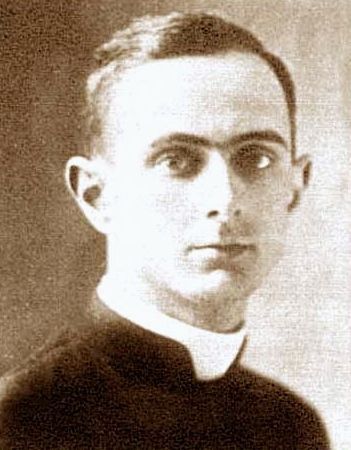
In 1954, Fr Montini was named archbishop of Milan, where he sought to win disaffected workers back to the Catholic Church. He called himself the “archbishop of the workers” and visited factories regularly while overseeing the rebuilding of a local Church tremendously disrupted by World War II.
In 1958, Montini was the first of 23 cardinals named by Pope John XXIII, two months after the latter’s election as pope. Cardinal Montini helped in preparing Vatican II and participated enthusiastically in its first sessions. When he was elected pope in June 1963, he immediately decided to continue that Council, which had another three sessions before its conclusion on December 8, 1965. The day before Vatican II concluded, Paul VI and Patriarch Athenagoras revoked the excommunications that their predecessors had made in 1054. The pope worked very hard to ensure that bishops would approve the Council’s 16 documents by overwhelming majorities.
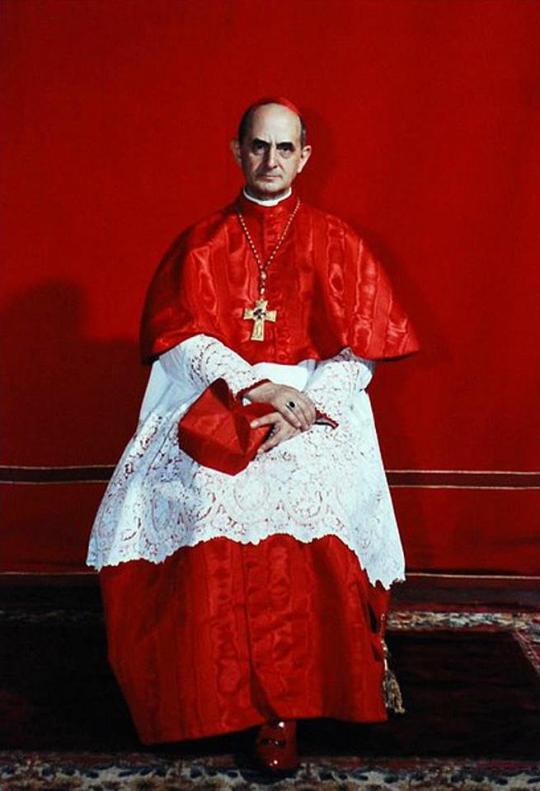
Paul VI had stunned the world by visiting the Holy Land in January 1964 and meeting Athenagoras, the Ecumenical Patriarch of Constantinople in person. The pope made eight more international trips, including one in 1965, to visit New York City and speak on behalf of peace before the United Nations General Assembly. He also visited India, Columbia, Uganda and seven Asian countries during a 10-day tour in 1970.
Also in 1965, he instituted the World Synod of Bishops and the next year decreed that bishops must offer their resignations on reaching age 75. In 1970, he decided that cardinals over 80 would no longer vote in papal conclaves or head the Holy See’s major offices. He had increased the number of cardinals significantly, giving many countries their first cardinal. Eventually establishing diplomatic relations between the Holy See and 40 countries, he also instituted a permanent observer mission at the United Nations in 1964. Paul VI wrote seven encyclicals; his last one in 1968 on human life–Humanae Vitae–prohibited artificial birth control.
Pope Paul VI died at Castel Gandolfo on August 6, 1978, and was buried in St. Peter’s Basilica. He was beatified on October 19, 2014.
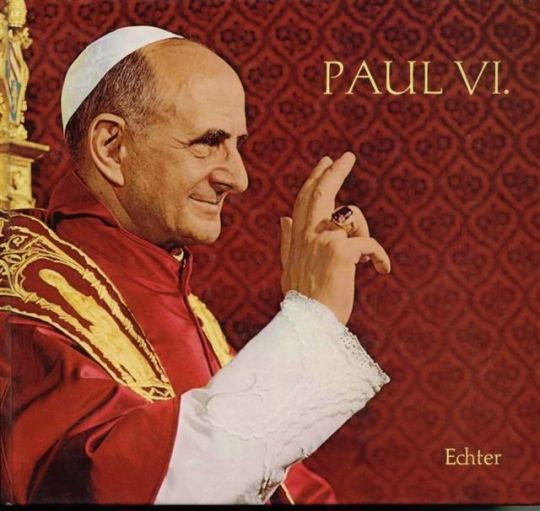
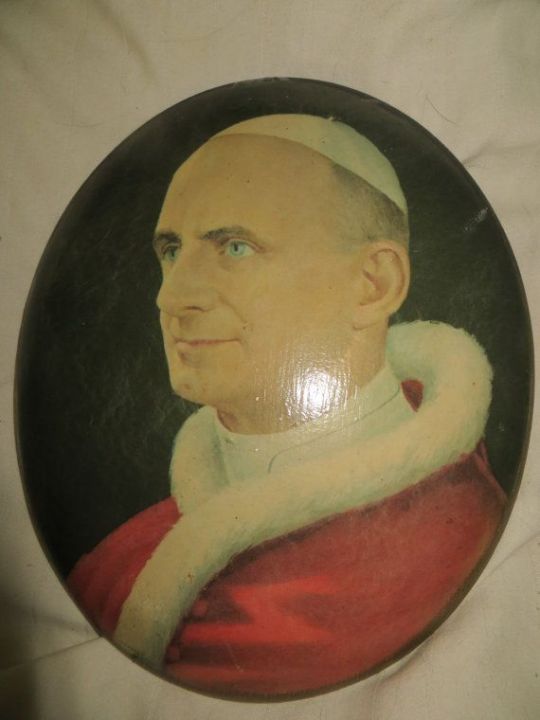
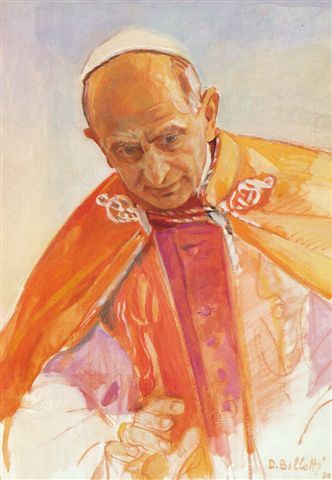
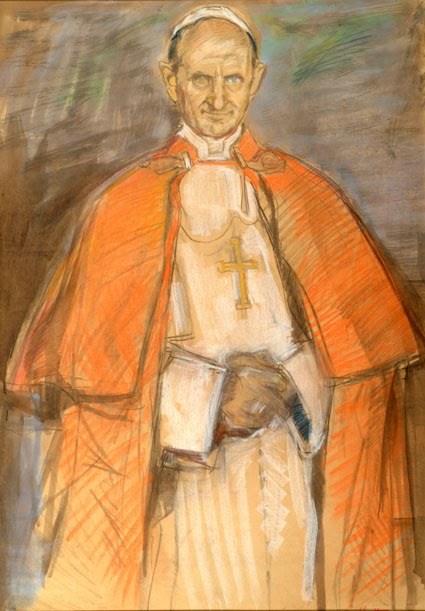
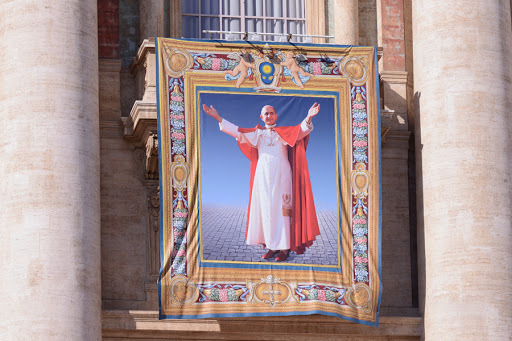
Pope Francis and Blessed Pope Paul VI – (The Image below is Pope Francis wearing his favourite stole. It is actually the stole that Blessed Pope Paul VI wore.)
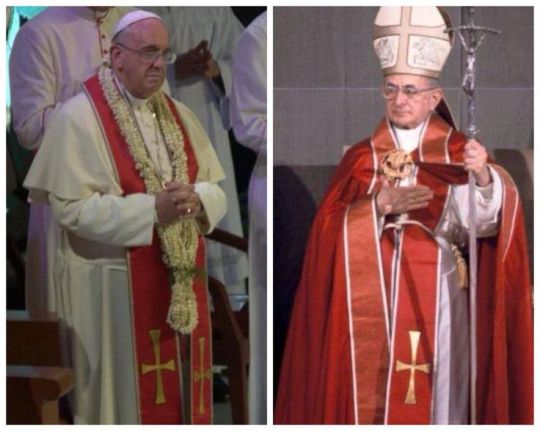
During his recent visit to Bozzolo, Italy, Pope Francis declared his desire to be able to canonise Paul VI.
According to a report today in the blog Il Sismographo, a miracle is being studied by the Congregation for Saints’ Causes, which if recognised, will pave the way for Blessed Pope Paul VI’s canonisation.
The miracle is related to the healing of a child on December 25, 2014, after a complicated pregnancy and a premature birth. The mother went to the Sanctuary of Graces in Brescia and prayed for Blessed Paul VI’s intercession for her tiny daughter’s survival.
“During his recent visit to Bozzolo, Pope Francis repeated his desire to canonise Paul VI,” noted Don Adriano Bianchi, director of the news service of Paul VI’s home diocese, Brescia, in a report on the subject in the journal Brescia oggi, on July 18.
The miracle approved for the beatification of Pope Paul VI (Giovanni Battista Montini) was also related to a difficult pregnancy. A woman was encouraged to abort her child because the baby was disabled. She refused the abortion and entrusted the baby to Paul VI’s intercession, because of his encyclical Humanae Vitae (1968). The infant survived, without any health concerns whatsoever. Paul VI was beatified on October 19, 2014, at the conclusion of the first Synod on the Family.
(via AnaStpaul – Breathing Catholic)
12 notes
·
View notes
Photo

Thought for the Day – 26 September – The Memorial of Blessed Pope Paul VI
Blessed Pope Paul’s greatest accomplishment was the completion and implementation of Vatican II. Its decisions about liturgy were the first ones noticed by most Catholics but its other documents—especially the ones about ecumenism, interfaith relations, divine revelation, religious liberty, the Church’s self-understanding and the Church’s work with the entire human family—have become the Catholic Church’s road map since 1965. (Fr Don Miller OFM)
Blessed Pope Paul VI, Pray for us!
(via AnaStpaul – Breathing Catholic)
#thoughtforthedayseptember26#september26blessedpopepaulVI#blessedpopepaulVI#mypic#catholic#catholicism
9 notes
·
View notes
Video
youtube
Tribute to Giovanni Battista Montini (Pope Paul VI) - On your Feast Day Blessed Pope Paul VI, we love you, we thank you, please pray for the Church, pray for us all! 26 September
7 notes
·
View notes
Photo

Quote/s of the Day – 26 September – The Memorial of Blessed Pope Paul VI
“For you deal here above all with human life and human life is sacred; no one may dare make an attempt upon it…. Respect for life, must find here ….in the Assembly, its highest affirmation and its most rational defense. Your task is to ensure that there is enough bread on the tables of mankind and not to encourage an artificial control of births, which would be irrational, in order to diminish the number of guests at the banquet of life.”

“We must see to it that enthusiasm for the future does not give rise to contempt for the past.”

“Never reach out your hand unless you’re willing to extend an arm.”

“Liturgy is like a strong tree whose beauty is derived from the continuous renewal of its leaves but whose strength comes from the old trunk, with solid roots in the ground.”
Blessed Pope Paul VI
(via AnaStpaul – Breathing Catholic)
#mypics#mypic#quotesofblessedpopepaulVI#quotesofthedayseptember26#september26blessedpopepaulVI#blessedpopepaulVI#catholic#catholicism#prolife#liturgy#tradition#charity
6 notes
·
View notes
Photo

Our Morning Offering – 26 September – The Memorial of Blessed Pope Paul VI (1897-1978)
Prayer for a Pure Faith Blessed Pope Paul VI
Lord, I believe: I wish to believe in You. Lord, let my faith be full and unreserved, and let it penetrate my thought, my way of judging Divine things and human things. Lord, let my faith be joyful and give peace and gladness to my spirit, and dispose it for prayer with God and conversation with men, so that the inner bliss of its fortunate possession may shine forth in sacred and secular conversation. Lord, let my faith be humble and not presume to be based on the experience of my thought and of my feeling; but let it surrender to the testimony of the Holy Spirit, and not have any better guarantee than in docility to Tradition and to the authority of the magisterium of the Holy Church. Amen
(via AnaStpaul – Breathing Catholic)
#mypic#ourmorningofferingseptember26#september26blessedpopepaulVI#prayerforapurefaith#lordibelieve#blessedpopepaulVI#prayerofblessedpopepaulVI#catholic#catholicism
6 notes
·
View notes
Photo

Blessed Pope Paul VI (1897-1978) - 26 September - Solemni hac liturgia- Credo of the People of God.
A pope remembered
Catholics remember Blessed Pope Paul VI for a number of key reasons – he oversaw and closed Vatican II, introduced the new rite of Mass, was the first pope to travel globally, began and fostered full communion with the Orthodox Church – in which the mutual excommunications (1054) were reversed and withdrawn and issued the immensely unpopular and widely rejected encyclical Humanae Vitae.
Many faithful Catholics hold the encyclical as the jewel in the crown of his pontificate, but also a thorn of sorrow – he never wrote another encyclical for the 10 years left of his pontificate, such was the backlash against it, including from within the church by bishops, priests and laity.
But there’s a real gem from Paul VI’s papacy that still, 47 years on, remains largely unknown, but it shouldn’t be.
Paul VI’s Year of Faith
On February 22 1967, Paul VI announced a Year of Faith, on the occasion of the nineteenth centenary of the martyrdom of the apostles Sts Peter and Paul.
Paul VI’s Year of Faith concluded in Saint Peter’s Square on June 30 1968. It was then that the hidden gem, the “solemn utterance” was given by this pope to the Church – his Credo of the People of God. The Credo was published an Apostolic Letter in the form of motu proprio, with the Latin title Solemni hac liturgia.
In the midst of disorientation and confusion in the Church and at a time when society was in the throes of the sexual revolution and the influence of atheistic communism, Blessed Pope Paul VI pronounced his Credo. “Today we are given an opportunity to make a more solemn utterance. “As once at Caesarea Philippi the apostle Peter spoke on behalf of the twelve to make a true confession, beyond human opinions, of Christ as Son of the living God, so today his humble successor, pastor of the Universal Church, raises his voice to give, on behalf of all the People of God, a firm witness to the divine Truth entrusted to the Church to be announced to all nations,” he said in his introduction to the Credo,” he announced.
A catastrophic time for the Church and the World
Paul VI was fully aware of the dire situation the Church and the world found itself in. Perhaps today’s Catholics will sympathise, as they look around at the rampant rates of abortion, rising cohabitation, divorce, the legalising of same-sex marriage and declining practice of the faith.
“We see even Catholics allowing themselves to be seized by a kind of passion for change and novelty,” he said, and lamented the “disturbance and perplexity in many faithful souls” because of harm being done to the deposit of faith.
The Credo he professed is based on the Creed of Nicea, which Catholics around the world recite every Sunday at Mass, “the creed of the immortal tradition of the holy Church of God” as Paul VI called it. Building on the Creed of Nicea, Paul VI’s Credo deliberately sought to be “to a high degree complete and explicit” because at a time of such terrible confusion and heterodoxy, clear teaching was more necessary than ever.
Special emphasis is made around the divinity of Christ, the doctrines on the Blessed Virgin Mary, the nature, structure and authority of the Church and her pastors, original sin, the inspired nature of sacred scripture, the sacrificial nature of the Mass and the doctrine of transubstantiation – in short, all the teachings of the Church at that time being doubted, rejected and “revised,” as exemplified by the Dutch catechism, published in 1966, and with the blessing of the Dutch bishops.
How the Credo came to be
In 2008, leading Italian Vatican reporter, Sandro Magister, wrote an article on the interesting history of how the Credo came about.
The French Thomist philosopher Jacques Maritain had the idea of Pope Paul VI issuing a profession of faith, spurred on by the publication of the Dutch catechism. Magister quotes a letter of Maritain to Cardinal Charles Journet. “The Sovereign Pontiff should draft a complete and detailed profession of faith, in which everything that is really contained in the Symbol of Nicea would be presented explicitly. This will be, in the history of the Church, the profession of faith of Paul VI.” Cardinal Journet photocopied the letter and gave it to the Pope when he next met him. Two days after Paul VI announced the Year of Faith, Maritain wrote, “Is this, perhaps, the preparation for a profession of faith that he himself will proclaim?”
Magister tells us that at the request of Paul VI, Maritain drafted a profession of faith. He finished it on 11 January 1968 and on the 20 January he sent it to Journet. The following day, Journet sent it to Paul VI. With a grateful acknowledgement, and a few amendments, the draft was became the Credo.
The Credo today
Since then, St. Pope John Paul II has given the Church the Catechism of the Catholic Church, publishing in 1992. Pope-Emeritus Benedict XVI made his own contribution in 2005, with his Compendium to the Catechism and Catholics still profess the Creed of Nicea at every Mass. 47 years on this month, let us join and make our own, the words and sentiments of Blessed Pope Paul VI, the next time we’re at Sunday Mass:
This is the Full Credo – http://w2.vatican.va/content/paul-vi/en/motu_proprio/documents/hf_p-vi_motu-proprio_19680630_credo.html
and here are the final two verses:
We believe that the multitude of those gathered around Jesus and Mary in paradise forms the Church of Heaven where in eternal beatitude they see God as He is and where they also, in different degrees, are associated with the holy angels in the divine rule exercised by Christ in glory, interceding for us and helping our weakness by their brotherly care.
We believe in the communion of all the faithful of Christ, those who are pilgrims on earth, the dead who are attaining their purification and the blessed in heaven, all together forming one Church; and we believe that in this communion the merciful love of God and His saints is ever listening to our prayers, as Jesus told us: Ask and you will receive. Thus it is with faith and in hope that we look forward to the resurrection of the dead and the life of the world to come.
Blessed be God Thrice Holy. Amen.
PAUL VI
“To the glory of God most holy and of our Lord Jesus Christ, trusting in the aid of the Blessed Virgin Mary and of the holy apostles Peter and Paul, for the profit and edification of the Church…we now pronounce this profession of faith.”
(via AnaStpaul – Breathing Catholic)
5 notes
·
View notes
Photo

One Minute Reflection – 26 September – The Memorial of Blessed Pope Paul VI
“But you will receive power when the Holy Spirit has come upon you and you will be my witnesses in Jerusalem and in all Judea and Samaria and to the end of the earth.”…Acts 1:8
REFLECTION – ” But above all, we place our unshakable confidence in the Holy Spirit, the soul of the Church and in theological faith upon which rests the life of the Mystical Body.”….Blessed Pope Paul VI (SOLEMNI HAC LITURGIA – (CREDO OF THE PEOPLE OF GOD) 30 June 1968

PRAYER – Holy God, through our Lord Jesus Christ Your Son in union with the Holy Spirit, with Mary Mother of the Church, St Joseph her spouse, the communion of Saints, we pray, be with us, lead us, guide us, never leave us. Blessed Pope Paul VI, today we pray to you to make our special intention, that you will constantly pray for the beloved Church of Christ, His Mystical Body, for us all, amen.
(via AnaStpaul – Breathing Catholic)
#mypics#mypic#acts1:8#blessedpopepaulVI#september26blessedpopepaulVI#oneminutereflectionseptember26#catholic#catholicism
3 notes
·
View notes